
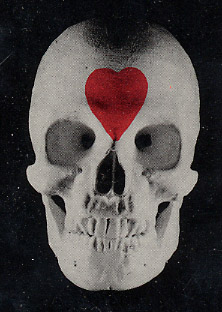




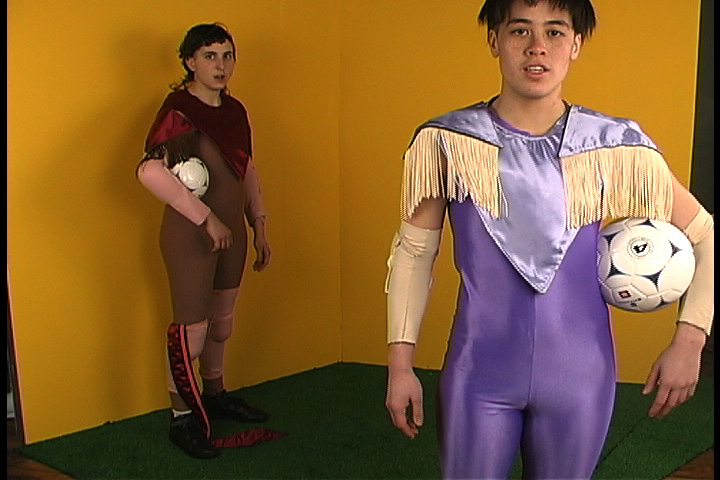
ELUSIVE QUALITY
Curated by Lauren Cornell and Astria Suparak
For EXPLOSION LTTR: the release of the third edition of feminist journal LTTR, “Practice More Failure”
@ PARTICIPANT INC., New York, NY
July 19, 2004. Tour and exhibitions through 2005
Videos and premieres by:
Lynne Chan, Mariam Ghani, Rohesia Hamilton Metcalfe, Caroline Koebel, Jeremy Laing and Will Munro, Math Bass and James (Wu) Tsang of Marriage, Tara Mateik, Seth Price, Chadwick Rantanen, Thorvaldur Thorsteinsson and toyshop
ELUSIVE QUALITY champions the realities of failure in relation to fantasies of athletic, sexual, and political mastery. Together, the works make for a powerful aesthetic of the undone. Consciously inglorious and imperfect, they reset the goalposts for success and then win at their own games. Nice jobs to all! Named after the stud Elusive Quality, sire to our almost national hero, the prize horse Smarty Jones, the program proposes: What may be sweeter than success are the thresholds crossed while making of all sorts of socio-personal mistakes.
PROGRAM
1. The Most Real Death (excerpts), Thorvaldur Thorsteinsson , 2000, approx. 2 min.
Documentation of 37 Swedes being shot by imaginary bullets while left alone in a room.
2. Mud Wrestle in The Earth Room, toyshop, 2004, approx. 2 min.
Toyshop crashes the untouchable art party (hosted by Walter de Maria), acting on their synesthetic feelings and keeping the line thin between earth and mud.
3. Demolition Derby, Lynne Chan, 2004, 10 min.
Skowhegan, Maine, Summer 2003. After a summer spent spattering himself with pink paint and combing body shops and thrift stores for suitably flashy automotive accessories, self-declared superstar JJ Chinois enters Demolition Derby combat two times. The first is a spectacular failure as his car stalls at the start line; the second is a success of gradual obliteration. A detour on his cosmopolitan-hopping world tour, Chinois’ dip into this local ritual of virility effects both a full-force embrace of the sport of demolition and a back-handed riff on its status quo.
4. Universal Games, Mariam Ghani, 2000, 2:20 min.
“Universal Games isolates, freezes, pairs, manipulates, and sequences images appropriated from one week of New York network TV news footage aired in October of 2000, when the two top stories were the Subway Series (The Yankees-Mets World Series of baseball) and the escalation of the Israeli-Palestinian conflict (the Al-Aqsa Intifada), in order to expose the strange similarity in the way our media outlets report stories of wildly varying gravity” – M.G.
5. Everyone Must Tighten Their Belts, Rohesia Hamilton Metcalfe, 1997, 4:30
“A whimsical piece in which a late-night television interviewer attempts to get an unusually wordy guest (a labor relations expert of sorts) to explain the relationship between unemployment and inflation. The language is repetitive to the point of becoming almost abstract in its rhythms— setting up an interplay between the ideas and the aural pleasures of the text.” – R.H.M.
6. I want to have your baby, Caroline Koebel, 2003, 6:10 excerpt
“Baby is global peace actionism subverting rightwing USA’s stranglehold on the concept of ‘family’ and its appropriation of such to justify the aggression machine. Participants become ‘moms’ who give birth to hypothetical babies, thereby repopulating the world with humane beings and crafting autonomous histories and radical futures. Each mom’s videotaped performance appears on the web and on a video compilation. BABY asks the international resistance to come together and digitally reproduce, generating the power of the many to overwhelm the ruling few.” – C.K.
7. PYT, Tara Mateik, 2004, approx. 4 min
“In Never Never Land identities collide and adult imperatives of binary gender have not yet taken hold. We suspend our disbelief and salute a constant state of preadolescent gender. In the tradition of the pantomime, the lead roll of Peter (the principal boy) is played by a woman. Michael Jackson plays the modern day Peter Pan in a state of arrested development. PYT throws social codes of masculinity into crisis and suggest MJ, Peter Pan, and (me) are theoretical and cultural transvestites. Imitation is the highest form of flattery.” – T.M.
8. Touch Cinema, Valie Export, 1968, 1:08 [included in the NY screening]
“Touch Cinema is a document of Valie Export’s famous street performance, in which the public was invited to touch her inside a curtained box attached to the artist’s upper torso. The work is a witty and confrontational comment on the objectification of women’s bodies.” – Electronic Arts Intermix
9. The Claw (excerpt), Chadwick Rantanen, 2003, approx. 4 min.
Rigged to crush the excitable and materialistic desires of youngsters, and to ease them into gambling with their milk money, crane machines almost became illegal in California. Rantanen is also from California. And he’s created a sunny alternative to chronic losing.
10. Fortunate Living Trilogy, Part I: Soccer, Marriage (Math Bass + Wu Tsang), 2004, 6 min.
“Soccer invites us to participate in the trans effeminate interception of hegemonic practices, a rupture of principle, discipline and athletic display. To build a set, the utilitarian body fits itself into a new form. We are champions of this changing prosthesis.” – Marriage
11. Rejected or Unused Clips arranged in order of importance, Seth Price, 2003, 11 min.
A collection of tossed clips from Price’s studio is tightly edited into a work that distills the artists’ continuing fascination with the ways authorial voice, masculinity and violence are insinuated into spiritual and material realms.
12. Inside the Pavillion of Virginia Puff-Paint, Jeremy Laing and Will Munro, 2004, 8:35 min.
“Peer through the glory hole into The Pavilion of Virginia Puff-Paint, porn superstar of the glittery craft underworld. Watch as this insatiably versatile vision of hand-stitched poly-sexuality tickles multiple lacy orifices with detachable foam-stuffed spandex cocks in a heavily embellished and much anticipated triple crossed-stitch debut release. Freshly plowed by a rhinestoned stiletto and dripping pearled entrails from padded stomach cavities, Virginia, having exhausted the possibilities for penetration, collapses in a shower of sequins.” – V.P.P.
Total running time: 62 minutes

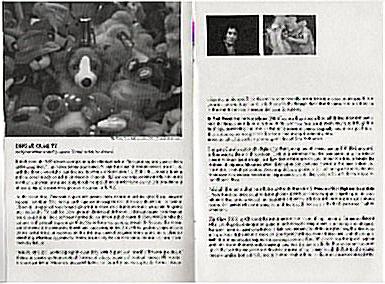
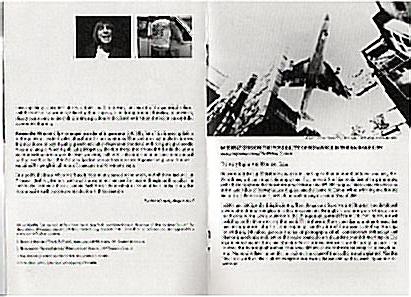
ESSAY
Fail Better
By Lauren Cornell
Originally printed in Black Diamond Magazine
August 2004
In its Report, the 9/11 Commission points to four kinds of failure – “imagination, policy, capabilities and management” – as causes for the government’s inept handling of terrorist threats to the U.S. and the drastic oversights that lead to the events of September 11, 2001.[1] This, coming from a nation so excessively confident of its socio-economic edge and sovereign destiny, marks a moment in which American myths are being forcibly dispelled, not just for those on the Left (who knew it all along, right) but across the political spectrum in the U.S.
At the same time, American pop culture persists in its optimism and its upward and outward (global) mobility. The media landscape assumes a pretense of responsibility and inclusion. However, this pose of post-liberated glory is just a fresh set of injustices coated with spin. Programs such as Reality TV and Fox News present illusions of difference, information and participation while, in actuality, these democratic principles are increasingly threatened. If one wonders why the cultural and political happenings of the ‘60s so haunt the present, it could be because this was an earlier moment of widespread dissent and questioning in the U.S., whose goals and legacies have yet to be fulfilled. In response to this contradictory state of progress, some artists have taken to visualizing what is so aggressively covered up, namely acute realities of economic, cultural and everyday failure.
Elusive Quality
“Elusive Quality,” the video program curated by Astria Suparak and myself, affirms the position of failure in relation to American-bred fantasies of athletic, sexual and political mastery. The works included, a few of which are discussed below, are formally and conceptually diverse. Some originated as site-specific performances not necessarily meant for single screen exhibition. In the program however, they are all linked temporarily through their shared consideration of how an embrace of failure can re-imagine the terms for success.
In “Mud Wrestle in The Earth Room” (2004) the toyshop collective drop a boombox and their scantily clad bodies onto the famous mud floor of Walter De Maria’s “New York Earth Room” (1977) to indulge in a brief orgy of wrestling until they are halted by a security guard. Originally meant as a good time, their action comes to express an irreverent and engaged reckoning with institutional art history by a younger generation of New York artists.
Emerging Canadian art outfit Virginia Puff Paint, composed of Jeremy Laing and Will Munro, revel in homo-erotic desire and perversion. Their lush performances offer a counterpoint to the hetero-normative issues (i.e. marriage) that have focused mainstream gay discourse of late. In “Inside the Pavilion of Virginia Puff-Paint” (2004), both artists don costumes covered with ornate orifices and removable, conical protrusions. Assuming different positions in their sumptuous tent, the two enact seemingly endless possibilities for penetration, until they collapse in an intimate tangle on the pillowed floor.
Political filibuster is taken on in Rohesia Metcalfe Hamilton’s “Everyone Must Tighten Their Belts” (1997). The short piece features a late night talk show host, interviewing an alleged expert on labor relations. Prompted to explain the relationship between inflation and unemployment, the expert evades the question by re-iterating it, until her speech becomes a rhythmic pattern of hollow repetition.
“The Claw” (2003) by Chadwick Rantanen satiates the desire of any current or former adolescent who has plugged a coin-operated game in the hopes of scoring a prize, and lost (again and again). Rantanen installed a crane machine in a dark, vacant room. Inside its large glass box, illuminated by a ring of small light bulbs, a lone claw dips repeatedly into a mound of colorful stuffed creatures, each time tenuously clasping one and sending it down a chute. Where one could only ever hope of attaining one of the furry, oddly shaped prizes, here the claw methodically empties out the entire space. By isolating the game outside of the context of say Coney Island, the lust for the strange prizes – ranging from animals, insects, fruit to cowboy hats – indicate a culture so obsessed with amassing things, it matters little what they are. In this way, the content of the game is displaced and the sheer act of winning is laced with a palpable, scintillating tension. The claw’s unwavering victory puts an end to the cycle of rising aspirations and deferred satisfaction that keeps our capitalist economies churning.
“Rejected or Unused Clips arranged in order of importance” (2003) by Seth Price is a compilation of forgotten or trashed video clips from the artist’s studio. The random array includes low-res internet videos of boys fighting, pseudo-scientific diagrams of emotional well-being and psychedelic visions of utopia. When tightly edited together, the clips merge into a work that distills the artist’s continuing fascination with the ways violence, authority and control are insinuated into spiritual and material realms. Price’s investigation reveals how systems of power are played out and sustained by people in all sorts of mundane and/or extreme ways.
In a political climate where the buck is consistently passed, these works, and all those included in “Elusive Quality”, demonstrate how failure can be an engine for creative thought and a catalyst for personal reflection and social action. Each work is imbued with a sense of hope and urgency that accompanies such processes of realization and reclamation.
CREDITS
Elusive Quality first screened at Participant, Inc in New York, in conjunction with the release of “Practice More Failure,” the third edition of feminist journal LTTR. http://www.lttr.org
Thanks to Astria Suparak for her collaboration and support of this essay, and to Michael Connor.
FOOTNOTES
[1] 9/11 Commission, 9/11 Commission Report (W.W. Norton & Company: 2004), 356.

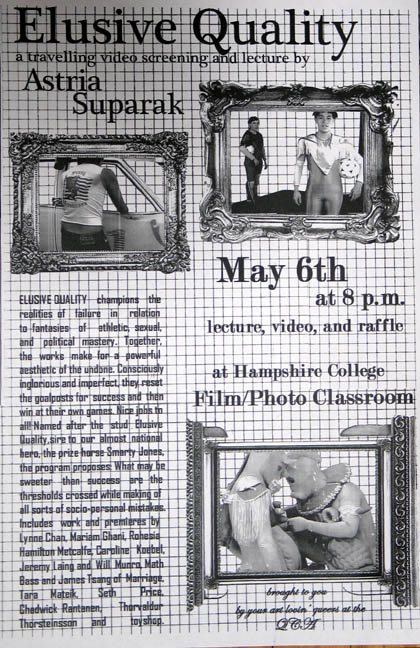
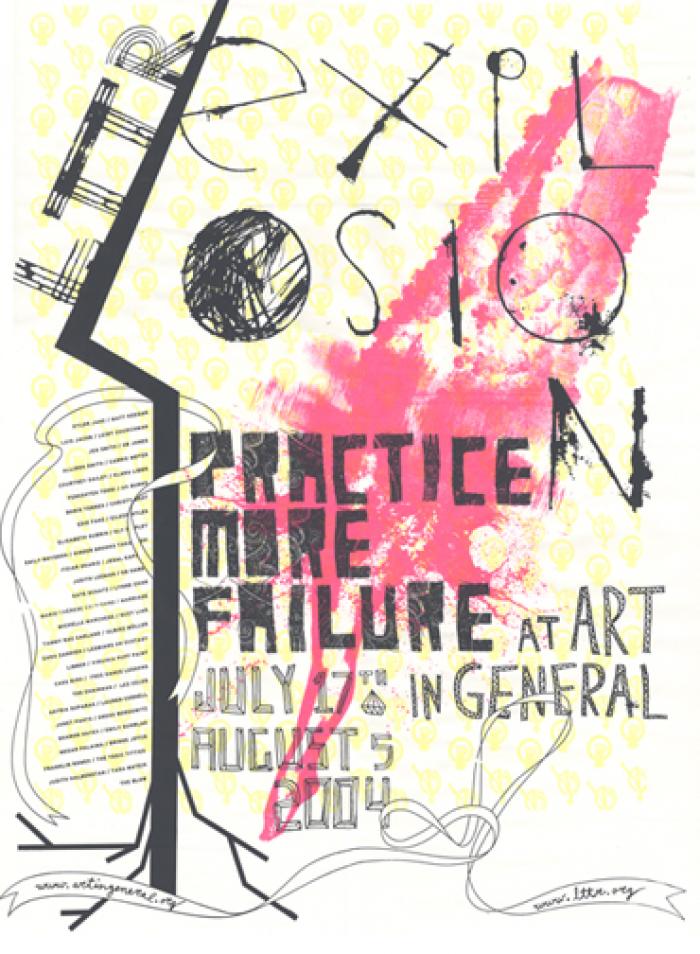

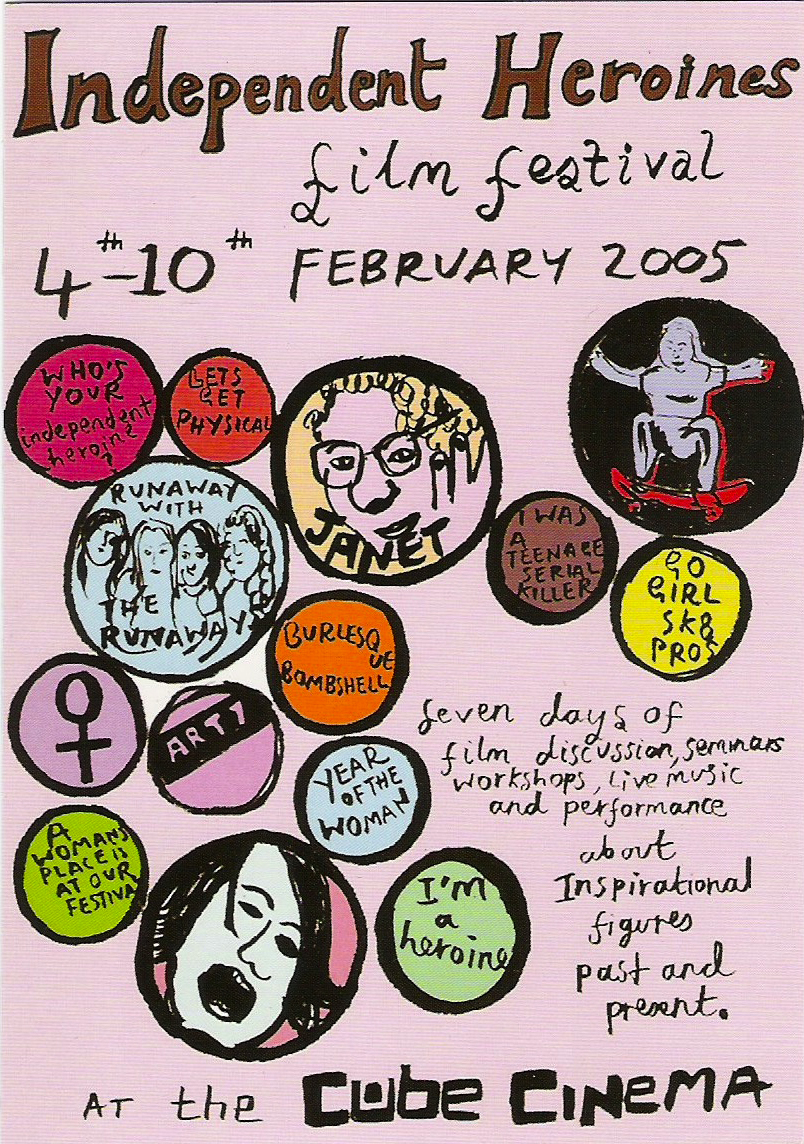

TOUR SCHEDULE
July 19, 2004, 8:30pm
Part of EXPLOSION LTTR, the release of the third edition of feminist journal LTTR, “Practice More Failure”
@ PARTICIPANT INC, 95 Rivington Street, Lower East Side, New York, NY
A collectively-made journal of aesthetics and protest, LTTR brings together a community of queer and feminist artists, writers, and cultural producers.
September 18-19, 2004
Liverpool Biennial of Contemporary Art 2004
@ FACT Center, The Foundation for Art & Creative Technology, Liverpool, England
“The Transparent Eyeball” program organized by White Diamond Projects and Michael Connor, including work and performances by Ara Peterson, Cory Arcangel, Peter Coffin, Paper Rad, Beige, and Suparak + Cornell.
September 18 – October 22, 2004, Wednesdays, 12-5pm *
@ The Mobile Cinema at the City Center Warehouse, 55 New Baird Street, Independent Quarter, Liverpool, England
October 9, 2004, 7 pm
@ The Hardware Store, 4916 Baltimore Ave, West Philadelphia, PA
a gay pants! event, with movies, Experimental Cake-Off!, chiara, The King Cobra (math, prog, metal, magic from Oly, WA with Rachel Carns formerly of The Need and Kwo)
February 9, 2005, 7:30pm
Independent Heroines 2005: Feminist Film Festival
@ Cube Cinema, 4 Princess Row, Kingsdown, Bristol, England
“IT AIN’T WHAT YOU DO, IT’S THE WAY THAT YOU DO IT,” an evening on the art of collaboration, including a screening of Elusive Quality, shorts by Iceland Love Corporation, and a discussion with IH curators and guests Emma Hedditch, Louise Short, more.
May 6, 2005, 8pm
@ Hampshire College, Film & Photo building, Amherst, MA
Followed by a raffle. Sponsored by Queer Community Alliance
* denotes exhibition
PRESS
NEW YORK TIMES, “ART IN REVIEW; ‘Explosion LTTR’,” Holland Cotter, Aug. 6, 2004, p E35
In late July, Art in General was host to a release party for the third issue of the excellent once-a-year art journal LTTR, and the place jumped with activity in the days that followed. LTTR stands for, among things, Lesbians to the Rescue. The journal is collectively produced, and a wide range of young gay and lesbian artists and feminists from across the United States and Canada came together in Manhattan to celebrate its release. The event was cross-disciplinary and communal in spirit, and as a political and cultural phenomenon it represents one of the more interesting developments in American art today.
For the occasion Art in General turned its big sixth-floor gallery into a space for music and dance performances, a collaborative reading by Judith Halberstam and Eileen Myles, a talk by the artist and filmmaker Gregg Bordowitz, and solo work by the performance artists Sharon Hayes, Megan Palaima and Emily Sunblad. Further activities, including a video program [Elusive Quality], spilled over into two Lower East Side galleries, Participant Inc. and Reena Spauling.
Finally, Art in General’s new street-level project space served as a studio, public workshop and gallery, with pairs of artists taking up collaborative residency for two days at a time. The accumulated output now on view includes posters by Cary Moyer, placards by Jen Smith, a large drawing (photographed from an e-mail) by G. B. Jones, furniture by Klara Liden, wall paintings by Leidy Churchman and Luis Jacob, and work by visitors and passers-by.
The idea of moving art out of the control of the professional art world underlies the thinking of many of the individuals and collectives associated with LTTR. To this end, Courtney Dailey and Ginger Brooks Takahashi founded the Mobilivre/Bookmobile, a van in which they have traveled the country displaying and selling artists’s books and zines, and holding workshops. Allison Smith, based in Brooklyn, is using Art in General as a recruiting station for a ”weekend encampment” in the Catskills, ”for all those who find themselves in the midst of war,” scheduled for Aug. 27 to 29. Chances are good that the convocation will have little in common, in tone or intent, with the international biennials and art fairs that define the art industry. But it may prove to be one more collective step in defining a new and different art history.
RELATED
- LTTR #2: LISTEN TRANSLATE TRANSLATE RECORD journal
- NYFA Current, “Setting a Pace: Andrea Geyer and LTTR,” by Amoreen Armetta, Vol. 14, #16, Aug. 2005
- A Non-Zero Sum Game sports series
- Other curated screenings and events (tag #events)
- Other publications (tag #writing-publications)